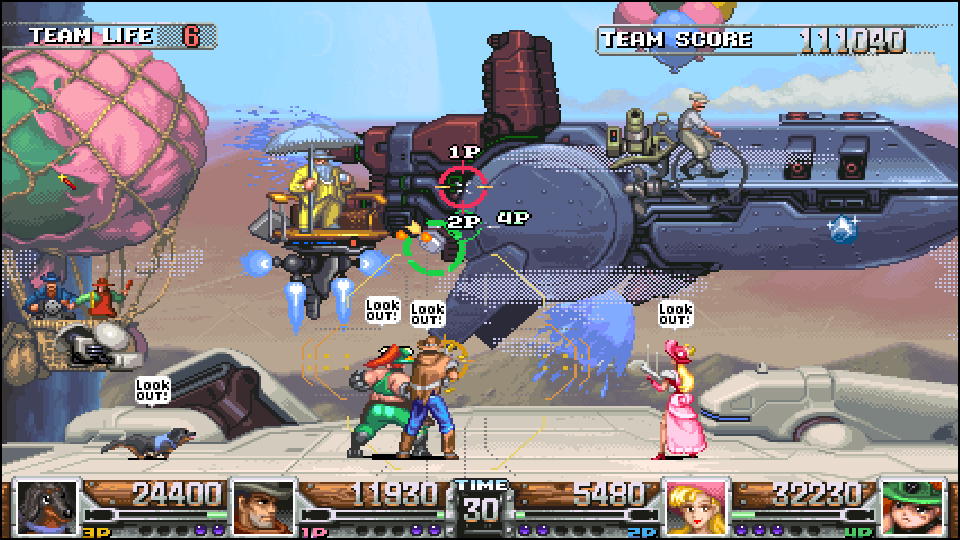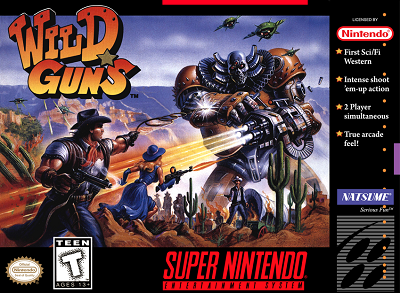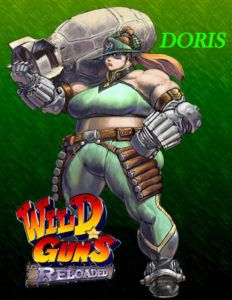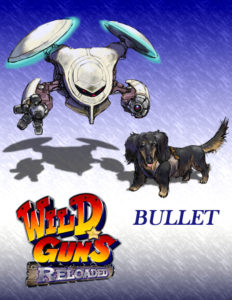It’s undeniable that there’s been renewed interest in certain retro genres as of late, but there’s one old-school arcade genre that rarely sees any modern-day love: the third-person crosshair shooter. The likes of Cabal, Blood Brothers, and NAM-1975 simply aren’t being made anymore in any format, and that’s extremely unfortunate.
So when Natsume announced that Wild Guns – a SNES game that served as both a loving tribute to the genre and one of its last great examples in the past few decades – was getting a revised an enhanced PS4 reissue as Wild Guns Reloaded… well, I knew that Gaming.moe would have to do something involving the game. This site is built on love for classic gaming genres and underappreciated gaming gems, after all! Even more exciting was the news that original development staff from Natsume-Atari was working on the game. Not only were they going to adapt the game for a new platform, but they planned to add all-new levels and characters as well! My hype was officially through the roof, and I doggedly pursued the chance to interview the game’s creators for a rare look into the creation of a true modern retro revival.
Thanks to the help of Mika and other great folks over at Natsume, we were able to arrange a discussion with Mr. Taka Maekawa, the game’s producer over at Natsume-Atari in Osaka. Please enjoy this exclusive interview about the creation of Wild Guns Reloaded — which, by the way, is now available on PSN and in a limited physical release!
Thank you for taking the time to answer our questions, Maekawa-san. What was the impetus for deciding to revive Wild Guns?
Natsume’s President and CEO, Hiro Maekawa, has a fond connection to the franchise. It was the first title Hiro worked on after taking over Natsume Inc., and he spent a great deal of time with the title. So when the opportunity came up to revive a franchise, Hiro suggested Wild Guns, and here we are! Not to mention that Wild Guns is known in circles as being one of the best arcade shooters for the SNES.
Wild Guns was well known among fans, but usually these sort of retro revivals are for old game series that haven’t seen a new installment in a while. However, there was only a single Wild Guns game before this. Do you feel that the nostalgia for this single title is strong enough to carry the new game?
For this game, the answer is definitely yes. Obviously, one of the things we look at is fan interest. Used copies of the game always sell for quite a high price on eBay, so definitely the demand for even the first game is still there. And, like you alluded to, the game really has a hardcore fanbase, so I think a follow-up was only natural and simply a matter of time. And that’s been confirmed to us throughout the process of the development of the game. The excitement at E3 for the game exceeded our wildest expectations, and that buzz has continued on message boards like NeoGAF, so we’re pleased to finally be able to get the game into the hands of consumers!
Who are the original staff members who are working on this title, and what roles do they have in production? Can they tell us a little bit about the inspiration behind the original game?
Absolutely. There’s the main planner and graphic designer, Shunichi Taniguchi, the programmer, Toshiyasu Miyabe, and the composer, Iwatsuki Hiroyuki. As far as the inspiration behind the original game goes, Taniguchi-san liked the arcade game Dynamite Duke (1989) and Miyabe-san was a big fan of the arcade game Blood Bros. (1990), and they thought about making a similar pseudo-3D shooting game themselves.
Wild Guns Reloaded manages to look and feel like a 16-bit game on a modern HD console. How did you produce the game’s visuals? Did you use the same sort of tools as you did when making the SNES game for authenticity, or did you use more modern elements of production?
Since the game was originally 16 bit, the development team wanted to keep the same feel in Wild Guns Reloaded. Tool-wise, the development process started off by creating the tools that allowed the team to display and edit 16-bit style graphics on the PS4. Once the tools were set, they began to develop the game in earnest. It might be easier to say that they intentionally limited themselves to the 16-bit mindset. Due to this, the development team tried not to use effects like scaling or rotation. For example, the animation of the rolling bullet cartridge (when the gun is shot) is made up of about 16 individual graphic patterns! This goes for the music, too. The development team first created a sound tool that allowed the game to sound like the original version, and from there, they re-arranged each of the songs.
The game’s two new characters, Doris and Bullet, are very unique and humorous designs. What inspired their creation? How do they add new elements to the gameplay?
The development team wanted to create new characters that had a completely different style of play from Clint and Annie. Doris, instead of using guns to attack, uses grenades to overpower the enemy, whereas Bullet uses his attack drone to lock on to enemies and make quick work of them.
There hasn’t been a new game in this genre of third-person crosshair shooters for a long time. Are you worried that players who haven’t played this sort of game before might feel overwhelmed? What features does the game offer to ease new players into this genre? Do you think players have moved away from shorter, arcade-style action games, or do you feel that the market for these sorts of titles on consoles is currently underserved?
Well, with things like the Virtual Console, I think a lot of younger players are more exposed to games like this than ever before. In addition, while the difficulty ramps up along the way, the first stage is quite straightforward, and does a good job of easing the player into the game so they know what to expect. Finally, and perhaps most importantly, there are 3 difficulty settings, so players who aren’t familiar with this kind of game at all can select the “Easy” option and get a more liberal helping of lives and less-aggressive enemies.
As far as players moving away from this kind of game, we think the popularity of other games like this available on XBLA, Virtual Console, and the like bodes well for the success of Wild Guns Reloaded.
After Wild Guns releases, do you see the potential to revitalize other Natsume-Atari properties?
Of course! If we feel the market for a revival of a Natsume game or franchise is out there, we’ll definitely pursue it.
Natsume-Atari did a lot of work with Taito during the 1990s. If this title does well, would the door be open for collaborations with them again?
While anything is possible, there can end up being unexpected red tape that prevents collaborations such as this, even if the original designers are on board with a potential project. Therefore, while it’s something we’d love to do, it’s not always up to us.
Is Wild Guns Reloaded fully PS4 exclusive, or is there a possibility it may appear on other platforms in the future? Would co-op netplay be considered for a future addition?
Well, we’ll first see how Wild Guns Reloaded does on the PS4, and then evaluate if there’s a market for it on other platforms. As for co-op netplay, we’ll see what happens!



